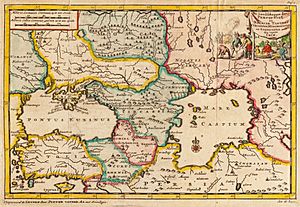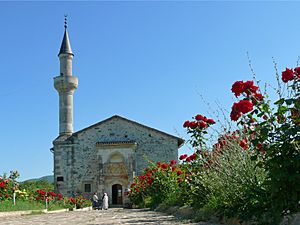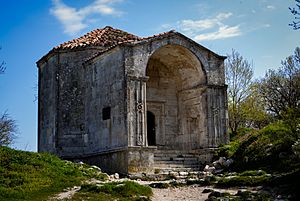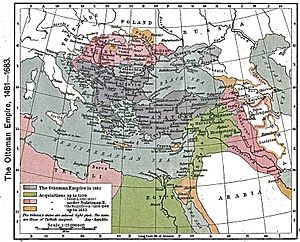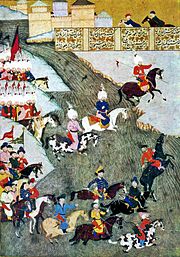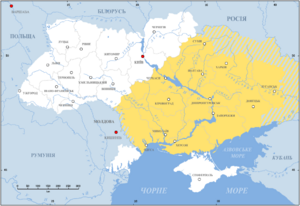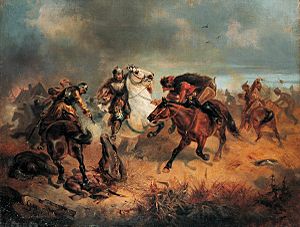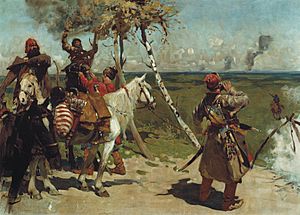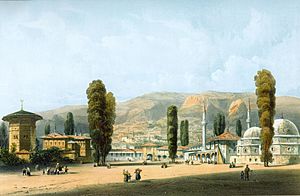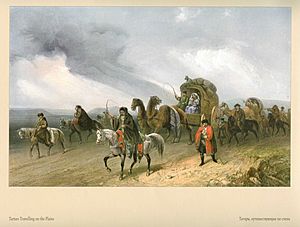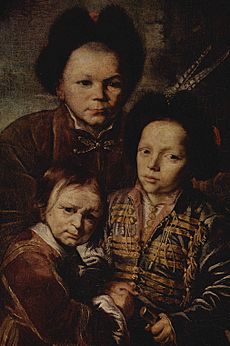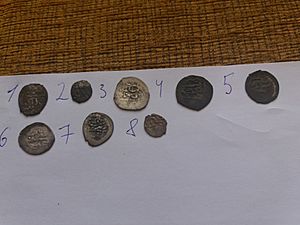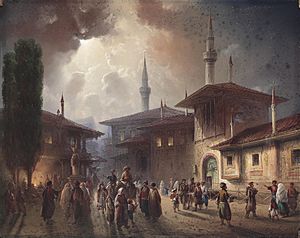Crimean Khanate facts for kids
Quick facts for kids
Throne of Crimea and Desht-i Kipchak
|
|||||||||||
|---|---|---|---|---|---|---|---|---|---|---|---|
| 1441–1783 | |||||||||||
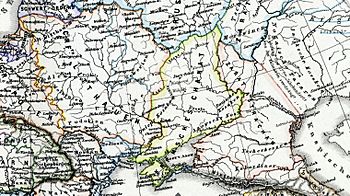
The khanate in 1550 (green)
|
|||||||||||
| Status | Khanate | ||||||||||
| Capital |
|
||||||||||
| Common languages |
|
||||||||||
| Religion | Sunni Islam | ||||||||||
| Demonym(s) | Crimean | ||||||||||
| Government | Elective monarchy | ||||||||||
| Khan | |||||||||||
|
• 1441–1466
|
Hacı I Giray (first) | ||||||||||
|
• 1777–1783
|
Şahin Giray (last) | ||||||||||
| History | |||||||||||
|
• Established
|
1441 | ||||||||||
|
• Annexation by the Russian Empire
|
1783 | ||||||||||
| Currency | Akçe | ||||||||||
|
|||||||||||
| Today part of | Moldova Russia Ukraine |
||||||||||
The Crimean Khanate was a powerful state of the Crimean Tatars. It existed from 1441 to 1783. The Khanate saw itself as the "Throne of Crimea and Desht-i Kipchak." It was the longest-lasting of the Turkic states that came after the Golden Horde empire.
Hacı I Giray started the Khanate in 1441. People saw it as the direct successor to the Golden Horde. In 1783, the Russian Empire took over the Khanate. This happened even though a treaty from 1774 said Russia and the Ottoman Empire should not interfere. Only France openly protested this takeover.
Contents
About the Crimean Khanate
The leaders of the Crimean Khanate, called Khans, believed their state was the true heir to the Golden Horde. They called themselves "Khans of the Great Horde, the Great State, and the Throne of Crimea." Their full title was very long and showed their claim over many lands and peoples.
The people living in the Crimean Khanate usually called their state "Qırım yurtu." This means "the country of Crimea" or "Crimean country." In old European writings, the area was sometimes called "Little Tartary." This helped tell it apart from "Great Tartary," which was a larger area in Asia.
The Khanate included the Crimean peninsula and the nearby flat lands (steppes). These lands are now mostly in southern Ukraine. The borders of the Khanate changed over time. This was because of constant attacks from groups like the Cossacks.
History of the Khanate
Early Beginnings

The first Turkic people arrived in Crimea in the 6th century. In the 11th century, the Cumans (Kipchaks) came. They later became important in the Golden Horde and the Crimean Khanate. By the mid-13th century, the northern steppes of Crimea became part of the Golden Horde. This is when the local Kipchaks started to be called Tatars.
The Golden Horde Khans were the main rulers of Crimea. But their governors, called Emirs, managed things directly. The first known ruler in Crimea was Aran-Timur. The city of Qırım (now Stary Krym) was an early center. Later, the areas around Chufut-Kale and Bağçasaray became important.
The people of Crimea were a mix of groups. These included Kipchaks, Crimean Greeks, Crimean Goths, Alans, and Armenians. Most nobles were of Kipchak or Horde background.
Life under the Golden Horde was often difficult. The Horde rulers sometimes attacked Crimea if people did not pay taxes. For example, Nogai Khan attacked in 1299, damaging many cities. Over time, people in Crimea wanted more independence.
In 1303, an important book called "Codex Cumanicus" was written in Crimea. It is in the Kypchak language, which is an old form of Crimean Tatar language.
There are stories that the Grand Duchy of Lithuania attacked Crimea in the 14th century. Grand Duke of Lithuania Algirdas is said to have defeated the Tatars in 1363. He then entered Crimea and took treasures from Chersonesos. His successor, Vytautas, also supposedly attacked Crimea in 1397. Vytautas is also known for giving a safe home to many Tatars and Karaites in Lithuania.
Canike Hanım, daughter of Khan Tokhtamysh, was an important figure. She supported Hacı I Giray in his fight for power in Crimea. Many believed she played a key role in making the Crimean Tatar state separate.
How the Khanate Started
The Crimean Khanate began in the early 15th century. Some groups from the Golden Horde decided to settle in Crimea. This area became their yurt (homeland). Before this, the Golden Horde had ruled Crimea since 1239.
Local leaders invited Hacı I Giray to become their Khan. He was a descendant of Genghis Khan. Hacı Giray came from exile in Lithuania. He fought for independence from the Golden Horde from 1420 to 1441 and won. After more internal struggles, he became Khan in 1449. He moved the capital to Qırq Yer, which is now part of Bakhchysaray. The Khanate included the Crimean Peninsula and the nearby steppes.
Becoming an Ottoman Protectorate
After Hacı I Giray died, his sons fought for control. The Ottoman Empire stepped in and made Meñli I Giray the new Khan. In 1475, Ottoman forces conquered Greek and Genoese cities on the Crimean coast. From then on, the Khanate became a protectorate of the Ottoman Empire. This meant the Ottoman Sultan had a say in choosing new Crimean Khans.
The Ottomans took control of the Crimean coast. But they still recognized the Khanate's rule over the steppes. This was because the Khans were descendants of Genghis Khan.
In 1475, the Ottomans even imprisoned Meñli I Giray for three years. When he returned, he accepted the Ottoman Empire's leadership. However, Ottoman Sultans treated the Khans more like allies than subjects. The Khans still made their own foreign policy in the steppes. They also minted their own coins and used their names in prayers. These were signs of their independence.
The Khans did not pay taxes to the Ottomans. Instead, the Ottomans paid them for their help in wars. Crimean cavalry was very important for Ottoman campaigns against Poland, Hungary, and Persia.
Defeating the Golden Horde
In 1502, Meñli I Giray defeated the last Khan of the Great Horde. This ended the Horde's claims over Crimea. The Khanate's first capital was Salaçıq, near Qırq Yer. Later, the capital moved to Bakhchysaray, founded in 1532 by Sahib I Giray. Both Salaçıq and Qırq Yer are now part of Bakhchysaray.
Slave Trade
The trade of enslaved people was a major part of the Crimean Khanate's economy. The Crimeans often raided lands in Eastern Europe to capture people. For every person captured, the Khan received a share. These raids were either official military operations led by the Khans or smaller raids by noblemen.
For a long time, the Khanate traded many enslaved people with the Ottoman Empire and the Middle East. It is estimated that about 2 million people were taken from Russia and Poland-Lithuania between 1500 and 1700. Caffa, an Ottoman city in Crimea, was a well-known slave market.
Historian Brian Glyn Williams estimates that in the 16th century, Poland-Lithuania lost about 20,000 people each year to Crimean slavery.
Relationships with Neighbors
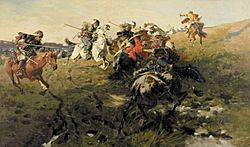
The Crimeans had a complex relationship with the Zaporozhian Cossacks. The Cossacks lived north of the Khanate in modern Ukraine. They helped protect Poland-Lithuania from Tatar raids and received money for it. They also raided Crimean and Ottoman lands.
Sometimes, the Crimean Khanate made alliances with the Polish–Lithuanian Commonwealth and the Zaporizhian Sich. For example, İslâm III Giray helped the Cossacks during the Khmelnytsky Uprising in 1648.
Fighting Muscovy
In the mid-16th century, the Crimean Khanate claimed to be the successor to the Golden Horde. This meant they claimed the right to rule over other Tatar states. This led to conflicts with Muscovy (Russia) for control of the region.
In 1571, Devlet I Giray led a successful attack on the Russian capital, Moscow. Moscow was burned, and Devlet I Giray earned the nickname "That Alğan" (seizer of the throne). However, the next year, the Khanate lost access to the Volga River after a big defeat in the Battle of Molodi.
Don Cossacks settled near the Don River by the 1580s. They became neighbors to the Khanate. They attracted people fleeing conflicts and hardship. Like the Zaporozhian Cossacks, the Don Cossacks protected Muscovy and also attacked the Khanate and Ottoman forts.
Decline of the Khanate
The Crimean Khanate began to decline as the Ottoman Empire weakened. The balance of power in Eastern Europe shifted. Crimean Tatars often returned from Ottoman wars without valuable goods. Also, the Ottomans paid less for unsuccessful campaigns.
Without modern weapons, the Tatar cavalry struggled against European and Russian armies. By the late 17th century, Russia became too strong for Crimea to raid easily. The Treaty of Karlowitz (1699) stopped further large raids. The era of major slave raids ended.
These losses led to internal conflicts among the noble families. The Nogays, who were a big part of the Crimean military, also started to withdraw their support.
In the early 17th century, the Kalmyks formed their own Khanate. They often fought against the Crimean Khanate. The Kalmyks later became allies of the Russian Empire. They helped Russia in many wars, providing many horsemen.
Russian and Ukrainian forces attacked the Khanate several times. During the Russo-Turkish War (1735–1739), the Russians managed to enter the Crimean Peninsula. They burned and destroyed much along their way.
More wars happened during the reign of Catherine II. The Russo-Turkish War (1768–1774) led to the Treaty of Kuchuk-Kainarji. This treaty made the Crimean Khanate independent from the Ottoman Empire but linked it to the Russian Empire.
The last Crimean Khan, Şahin Giray, saw growing Russian influence. There were also conflicts within his administration. On April 8, 1783, Catherine II took over the entire peninsula. This was against the treaty. Şahin Giray later fled to the Ottoman Empire and was executed. The royal Giray dynasty still exists today.
Government and Society
All Khans belonged to the Giray dynasty. This family claimed its right to rule because they were descendants of Genghis Khan. This was important in the steppe tradition.
While the Giray dynasty was the symbol of power, the Khan ruled with the help of noble clan leaders called Qaraçı Beys. Important clans included Şirin, Barın, Arğın, and Qıpçaq. After the Astrakhan Khanate fell, many Nogays joined the Crimean Khanate. Circassians and Cossacks also sometimes played a role in Crimean politics.
The Nogay nomads living north of the Black Sea were under the Crimean Khan. They were divided into several groups like Budjak, Yedisan, and Kuban.
Inside the Khanate
Inside the Khanate, the land was divided among the Beys. Below the Beys were mirzas from noble families. Peasants and herders were free. Sharia (Islamic law) protected their rights. Land was worked together by villages, and taxes were for the whole village. The tax was usually a small part of farm products or animals.
The last Khan, Şahin Giray, tried to change the internal structure. He made the nobles' lands belong to the Khan. These lands were then organized into qadılıqs (provinces managed by the Khan's representatives).
Crimean Law
Crimean law was based on Tatar law and Islamic law. The leader of the Muslim community was the mufti. His main job was to manage the finances of religious lands. Another Muslim official, the kadıasker, oversaw the Khanate's courts. Each court had a kadi (judge).
Non-Muslim Groups
Many non-Muslim groups lived in the Khanate. These included Greeks, Armenians, Crimean Goths, Adyghe (Circassians), Venetians, Genoese, Crimean Karaites, and Qırımçaq Jews. They mostly lived in cities, often in their own areas.
Under the millet system, they had their own religious and legal systems. They paid extra taxes but did not have to serve in the military. They often spoke dialects of Crimean Tatar.
The Jewish population lived mainly in Chufut-Kale ('Jewish Fortress'). This was a separate town near Bahçeseray. They spoke a Turkic language and had special rights. Both Christians and Jews in Crimea were involved in the slave trade. They also helped buy freedom for Christian and Jewish captives.
Economy of the Khanate
The nomadic Crimean Tatars and Nogays raised cattle. Crimea had important trading ports. Goods from the Silk Road were sent from these ports to the Ottoman Empire and Europe.
The Crimean Khanate had many large cities. These included the capital Bakhchysaray, Gözleve (Yevpatoria), Karasu Bazaar, and Aqmescit. These cities had many inns for travelers and merchants, tanneries, and mills. Many buildings from the Khanate were destroyed after the Russian invasion. Mosques were often torn down or turned into Orthodox churches.
Settled Crimean Tatars were involved in trade, farming, and crafts. Crimea was known for growing wine, tobacco, and fruit. Carpets from Bakhchysaray were sent to Poland. Knives made by Crimean Tatar artisans were highly valued. Crimea also produced silk and honey.
The slave trade was a major source of income for the Crimean Tatar and Nogai nobility. Raiders would capture Christian peasants from the countryside and enslave them. Despite the dangers, Polish and Russian serfs were drawn to the freedom of the empty steppes of Ukraine. These raids became part of Russian and Cossack folk tales.
The last major Crimean raid before the Russo-Turkish War (1768–1774) happened during the reign of Peter the Great.
Crimean Art and Architecture
Selim II Giray Fountain
The Selim II Giray fountain, built in 1747, is a masterpiece of Crimean engineering. It used small ceramic pipes in an underground tunnel to bring water from a spring far away. It was one of the best water sources in Bakhchysaray.
Bakhchisaray Fountain
Qırım Giray was an important builder of Crimean art. In 1764, he asked Omer the Persian to build the Bakhchisaray Fountain. This fountain, also called the Fountain of Tears, is famous. It is said to show the love of Khan Qırım Giray for his young wife and his sadness after she died. The Khan was known for being tough, but he cried when she passed away. He ordered a marble fountain to be made, so it would "weep" forever, just like him.
Regions and Administration
The Crimean Khanate had nine regions outside the Crimean Peninsula. These included the Kaztsiv ulus in Kuban and various Nogay Hordes like Yedychkul and Budjak.
The peninsula itself was divided among the Khan's family and several beys. A Bey's land was called a beylik. The Khans directly controlled Chufut-Kale, Bakhchysaray, and Staryi Krym. They also owned salt lakes, nearby villages, and forests.
The Kalga was next in line to the Khan. He usually managed the eastern part of the peninsula and was the army's chief commander when the Khan was away. The Nureddin was another important position, also held by a member of the Khan's family, managing the western region. The Khan's mother or sister held the position of Ana-beim, similar to the Ottoman valide sultan. The Khan's senior wife, Ulu-beim, was also very important.
Towards the end of the Khanate, kaimakans were created to manage smaller regions. Or Qapı (Perekop) had a special status. Its fortress was controlled either by the Khan's family or the Shirin family.
Images for kids
See also
 In Spanish: Kanato de Crimea para niños
In Spanish: Kanato de Crimea para niños
|
|
|




